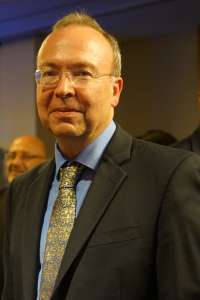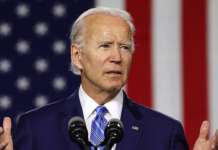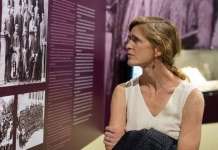 1- How do you want to introduce yourself to the readers of “ABAKA”, indicating your biographical lines and current activities?
1- How do you want to introduce yourself to the readers of “ABAKA”, indicating your biographical lines and current activities?
In my professional life, during the last seven years, I have had a dual responsibility: I am simultaneously the executive director of the Tekeyan Cultural Association (TCA) of the United States and Canada and the managing editor of the Armenian Mirror-Spectator, which is supported by TCA. The first job is primarily an administrative one, as I connect with our chapters and members in North America, and try to coordinate a number of our activities together with our Central Board. I often interact with other Armenian institutions and organizations on behalf of TCA and serve on various interorganizational community bodies.
I author my own articles for the Armenian Mirror-Spectator and edit the writings of others, as well as do some of the technical work for the maintenance and dissemination of the website version of the Mirror-Spectator.
By training, I am an historian specializing in modern Armenian history. After studying other fields as an undergraduate at Princeton University, and obtaining a master’s degree at the University of Pennsylvania in international relations, I completed all doctoral work at UCLA in Armenian history except a dissertation, and have published a number of academic articles on Armenians in the Ottoman Empire and Iran. My particular interest is the Armenians of Kozan (Sis) and Marash sancaks in the Young Turk period, including the 1909 massacres, the Armenian Genocide and the period of French and British occupation after World War I, as well as the fate of Dort Yol and some other parts of Cilicia. I have occasionally done translations of various works into English from French, Turkish, Ottoman and Armenian, primarily as a source of income, and edited other works. I periodically give lectures on Armenian history.
I worked for some 16 or 17 years at the Krikor and Clara Zohrab Information Center of the Diocese of the Armenian Church of America (Eastern) in New York immediately after UCLA, first as assistant director and then as director. The Zohrab Center was at the time a medium-size library and research center helping disseminate information on Armenian history and culture, and had at its peak 7 staff members.
I was born in the United States of Armenian parents. Our origins are from Sepasdia, Amasya, Bursa and Moush. On my father’s side, I am first generation, as my father was born in Turkey, but my mother was born in the US, and her father and great-grandmother came to the US prior to the Armenian Genocide. My wife is a neuropathologist originally from Yerevan, so we speak a mix of Armenian dialects at home. I am the proud father of two sons, the eldest of whom, Mark Antranig, is studying at McGill in Montreal. That gives me an extra incentive to visit this beautiful city and its Tekeyan Center.
2- Please can you give us a historical overview of The Armenian Mirror-Spectator.
The Armenian Mirror-Spectator was founded in 1932 as the English-language organ of the Armenian Democratic Liberal Party. It provides wide-ranging coverage of Armenian politics, culture and community events and has correspondents in Armenia and Artsakh, the East and West Coasts of the US, and various parts of Europe. In its print version it is a weekly newspaper but it posts more often on its website (mirrorspectator.com), where it also can include more images and occasionally videos. The website was completely redesigned several years ago to allow for a more modern look and flexibility. Over the same period of time, the newspaper developed a large email list to which we send excerpted dispatches at least twice weekly. Aside from myself, we have editor Alin Gregorian, staff writer Harry Kezelian and designer Mark Mgrdich as permanent staff, along with financial administrator Hasmik Saroyan, while Edmond Azadian is our senior editorial columnist.
3- Surely during these many years you have faced many challenges, be they community or personal as a national figure. Do you want to remember the most important of them and what solutions have you adopted?
Outside of my academic work and journalistic writing, whatever I have done, I have achieved together with all the dedicated members of the Tekeyan Cultural Association. I can’t say that there are any permanent solutions in our field of action, as it requires unceasing work. Much of this relies on the efforts of volunteers, and we are fortunate to have many.
Together with our active Central Board members, we ran campaigns to provide aid to Armenia during the 2020 Artsakh War, help the Tekeyan School of Beirut during its recent great difficulties, help wounded soldiers and the families of soldiers killed during duty during the April 2016 war, aid the Hrant Dink School of Istanbul, continue the Sponsor a Teacher program in Armenia and Artsakh, and help many other worthy causes. We are not primarily a philanthropic organization but we had no choice but to help during significant crises.
In our more traditional cultural and educational sphere, our organization sponsored tours of cultural significance such as that of the UCLA Vem group in North America, and supported lecture tours of writers and cultural figures, including from Armenia. We continue our publishing program for Armenian literature and support theatrical groups and newspapers, as Abaka readers are aware.
I can add that we were able to overcome to a certain degree the challenges of the covid pandemic through the use of Zoom and other modern technology, but we still have to restore some of the personal connections that were temporarily severed. Hopefully, widespread vaccinations and better treatments will allow more activity in 2022.
4- In your opinion, these days what is the challenge facing the Diaspora’s Armenian people in general and the American-Armenian people in particular?
The perennial challenge for Armenians living in the diaspora is the development and transmission of their Armenian identity to the ensuing generations. There is no easy solution to this. In the United States and Canada, without great effort it is not possible to maintain Armenian culture because daily life takes us to realms where we normally do not spend much time or thought on Armenian-related issues. Use of the Armenian language is even more restricted in most of our lives.
The second area in which there are ongoing significant challenges is the preservation of an Armenian state on what remains of our historic homelands in the Republic of Armenia and Artsakh. We appear to be in a critical era for these states, which are threatened by the two Turkic states of Azerbaijan and Turkey, and the Armenian diaspora cannot remain indifferent to this.
A third related area is the fate of Armenian communities facing physical or economic threats to their existence in the Middle East. Again, whether or not we have immediate family from these countries, Armenians living in North America have an opportunity to provide these communities assistance in various ways.
5- How do you assess the role of the press in general and The Armenian Mirror-Spectator in particular to meet all these challenges?
The press or media in general has an important role to play in preserving and developing Armenian identity in the diaspora. The media can play an educative role on Armenian politics, culture, history and so forth for its readers, as well as serve as a link to the homeland and other communities. It can help Armenians locally know what is going on around them and allow them to connect with organizations and events in their own areas. It can act also as an outlet for Armenians who wish to write or express opinions. It played a more important role in the past prior to the advent of the internet, but I believe that the role of editing and assembling information so that it is readily accessible and coming from a trusted source still is an important role of the press and its connected websites. The media also can play an important role in rallying community opinion in support of Artsakh, Armenia and various Armenian communities at risk. It can support fundraising efforts and political action.
The Armenian Mirror-Spectator attempts to do all of the above. It operates on a limited budget financially but it is always trying to improve its services and welcomes suggestions and assistance from the community. It at times receives requests outside of the formal range of its operations for information and contacts from individuals, and in providing that information on a personal level it again strengthens ties in the Armenian diaspora and with Armenia and Artsakh. It has supported various fundraising campaigns for Armenia, Artsakh and Middle Eastern communities in crisis, not only in the name of the Tekeyan Cultural Association or the ADL but also for other worthy organizations and projects.
6- You as an experienced community leader, what are your future plans?
In connection with the Mirror-Spectator, I would like to increase readership, both online and print, as well as digital advertising, and continue to improve our content by finding new English-language writers in different parts of the world. Hopefully this will serve the broader mission of the newspaper.
For the Tekeyan Cultural Association, I believe that it is most important to increase membership among the younger generation. Of course, this is what all Armenian organizations would like, and it is a difficult task. We need to expand beyond the boundaries that we have kept for ourselves both in terms of membership and programming. While we are dedicated to the preservation of Armenian language and literature, and in particular to Western Armenian, we have to also do programming in Eastern Armenian and English, and address the interests of younger people. The first generation of Tekeyan leaders who were born largely in the Middle East are now gradually leaving the scene, and we need to find a way to involve more Armenians born in North America, as well as immigrants from other countries.
I believe that with our focus on Armenian culture we have an important role to play in many communities where we do not now have active chapters. I hope that with time we can both strengthen our existing chapters and activate new ones.
I also hope to find the time eventually to finish some academic articles on issues of modern Armenian history.
7- What special words do you have to address to the readers of “ABAKA”?
Canadian Armenians are fortunate to have a trilingual newspaper at their disposal both in print and in the digital realm. I think that a platform that can provide the best of what is available in all three languages has more means to enrich the lives of its readers. Abaka is an asset to our community. I hope that in turn more readers will actively participate by writing for it and sending it relevant photos and videos, as well as supporting it financially. In this way, they can keep people better connected, help Abaka grow and increase our understanding of Canadian-Armenian life.










